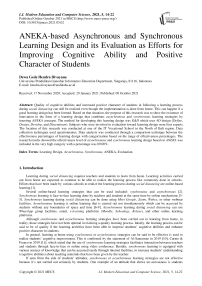ANEKA-based Asynchronous and Synchronous Learning Design and its Evaluation as Efforts for Improving Cognitive Ability and Positive Character of Students
Автор: Dewa Gede Hendra Divayana
Журнал: International Journal of Modern Education and Computer Science @ijmecs
Статья в выпуске: 5 vol.13, 2021 года.
Бесплатный доступ
Quality of cognitive abilities and increased positive character of students in following a learning process during social distancing can still be realized even though the implementation is done from home. This can happen if a good learning design has been formed. Based on that situation, the purpose of this research was to show the existence of innovation in the form of a learning design that combines asynchronous and synchronous learning strategies by inserting ANEKA concepts. The method for developing this learning design was R&D which uses 4D design (Define, Design, Develop, and Disseminate). Subjects who were involved in evaluation toward learning design were four experts. The location of this research was conducted at one of the IT Vocational School in the North of Bali region. Data collection techniques used questionnaires. Data analysis was conducted through a comparison technique between the effectiveness percentages of learning design with categorization based on the range of effectiveness percentages. The research results showed the effectiveness level of asynchronous and synchronous learning design based on ANEKA was included in the very high category with a percentage was 89.00%.
Learning Design, Asynchronous, Synchronous, ANEKA, Evaluation.
Короткий адрес: https://sciup.org/15017717
IDR: 15017717 | DOI: 10.5815/ijmecs.2021.05.02
Текст научной статьи ANEKA-based Asynchronous and Synchronous Learning Design and its Evaluation as Efforts for Improving Cognitive Ability and Positive Character of Students
Learning during social distancing requires teachers and students to learn from home. Learning activities carried out from home are expected to continue to be able to realize the learning process like commonly done in schools. Efforts that have been made by various schools to realize the learning process during social distancing are online-based learning [1].
Several online-based learning strategies that can be used included: synchronous and asynchronous [2]. Synchronous learning is face-to-face learning done by teachers and students at the same time by online mechanisms [35]. Synchronous learning during social distancing can be done using Meet Google , Zoom , Webex , or other webinar facilities. Asynchronous learning is online learning that is carried out not simultaneously which can be accessed by students without any boundaries of space and time [6-9]. Asynchronous learning during social distancing can use WhatsApp group facilities, email, e-learning platforms ( Moodle , Schoology , Kelase ), and other online learning platforms.
Although synchronous and asynchronous learning strategies have been carried out in learning from home, in reality, those strategies have not been optimal in realizing a quality learning process. Ideally, the learning process can be said to be of quality if the learning activities have been able to improve students’ cognitive abilities and enhance positive character in students.
In general, learning at home using synchronous or asynchronous strategies can be said to be effective is used to realize students’ cognitive improvement. This is confirmed by the statement of Al-Samarraie in 2019 [10]; Carmo & Franco in 2019 [11]; which stated that the use of synchronous learning strategies facilitates interaction between teachers and students through face-to-face or online using video conference. Besides, synchronous learning is equipped with various sources of knowledge that can be accessed easily through internet facilities, to increase students’ understanding (cognitive abilities) about teaching materials that have been given by the teacher.
If seen from the side of students’ attitudes, synchronous or asynchronous learning strategies are not effective because it’s not carried out seriously by students. One example of an attitude that shows un-seriousness is students commit cheating while participating in synchronous learning using Meet Google. Some students pretend to actively participate in learning activities by still login into the meeting room, but the fact they play truant by mute the microphone and turn off the camera facilities provided at Meet Google. Another example that shows students’ bad attitudes is students using internet facilities to look for negative things and not seriously looking for other sources of knowledge to support subject matter and assignments given by the teacher.
Some of the innovations offered to solve those problems included: 1) inserting the concept of local wisdom in the use of online learning platforms so that student’s attitude can be observed in the learning process; 2) activate the camera on the online platform automatically during the learning process; 3) inserting the ANEKA concept into synchronous and asynchronous learning strategies so the cognitive ability and positive character of students can be measured properly.
One of the best innovations were offered to solve that problem was to create a design that combines synchronous and asynchronous learning strategies with the ANEKA concept. Based on that innovation, the thing to be achieved in this research is expressed through research questions.
The research question in this research was how the effectiveness of ANEKA -based synchronous and asynchronous learning design was used in the learning process during social distancing ? The main purpose of this research was to show the existence of innovation in the form of an effective learning design used as a basic guideline in realizing an increase in cognitive abilities and the positive character of students in the learning process during social distancing .
-
2. Literature Review
This research is motivated by the research was conducted by Shahabadi & Uplane in 2015 [12] that showed the merging of synchronous and asynchronous strategies to facilitate quality learning processes even though only through the online system. The meaning and quality of face-to-face learning in the classroom can still be felt through a synchronous strategy even though it is not done directly in the classroom. Material transfer and searching for learning resources can also be done through asynchronous strategies without being limited by space and time. However, the obstacle in Shahabadi & Uplane’s research was that students’ positive attitudes were not demonstrated yet in the synchronous and asynchronous learning process.
-
3. Method
Perveen’s research in 2016 [13] showed synchronous and asynchronous integration is preferred by students in the learning process. The synchronous and asynchronous combination is well and clearly shows the relationship between technology, pedagogy, content, and the context of learning design. However, Perveen’s research obstacle had not yet to insert the local wisdom that is used to determine the extent of students’ perceptions and their positive attitudes in following the synchronous and asynchronous learning process.
Arasaratnam-Smith & Northcote’s research in 2017 [14] showed the advantages of online learning environments as unique media that are packaged in asynchronous and synchronous forms. The advantages of asynchronous learning are that allows students to provide deeper responses without any time restrictions and without the direct social pressure that normally occurs in synchronous learning. The advantages of synchronous learning are that allows students to respond directly when face to face. The obstacle of Arasaratnam-Smith & Northcote’s research was that positive aspects had not been shown yet as students’ responses to the existence of asynchronous and synchronous learning.
Dada et al .’s research in 2019 [15] showed that synchronous and asynchronous integration can improve student cognitive performance. However, the research obstacle of Dada et al . was the merging of synchronous and asynchronous had not been able to show evidence of increasing the positive students’ attitudes.
Research by Cacheiro-Gonzalez et al . in 2019 [16] showed the use of learning platforms that are equipped with synchronous and asynchronous modes to facilitate distance education. The research of Cacheiro-Gonzalez et al .’s also had an obstacle. It had not been specifically demonstrated yet the students’ perceptions in increasing their positive attitudes in the following of learning by the synchronous and asynchronous platforms.
-
A. Research Approach
This research was development research using the R&D development method with a 4 D design consisting of four stages, such as Define , Design , Develop , and Disseminate [17,18]. The things were done at the Define stage, including 1) front-end analysis, 2) student analysis, 3) task analysis, 4) concept analysis, and 5) determination of learning objectives.
Front-end analysis was carried out to obtain information related to the learning process problems that occur at school. Analysis of students was conducted to find out information related to students’ readiness in participating in learning following the learning strategies set by the teacher. The task analysis was conducted to obtain information related to the specifications of the equipment needed in the learning process, and the tasks of the personnel involved in the learning process. Concept analysis was conducted to obtain information related to concepts that would be incorporated into the learning design. The determination of learning objectives was conducted to obtain information related to the main purpose of the learning process using learning design innovation.
The things that were conducted at the Design stage, including 1) determining the design components, and 2)
sketching the design. The determination of design components intends to provide information related to the components needed in making a design. The design sketch is intended to display the form of learning design.
The things that were conducted at the Develop stage including 1) expert’s evaluation and 2) design revisions. Expert’s evaluation was conducted to evaluate the effectiveness of the design that was created. Design revisions were conducted to follow up on the advice of experts and the results of the effectiveness percentage that was still lacking. The things that were conducted at the Disseminate stage was to disseminate and implement learning designs that had been successfully created at the design stage.
-
B. Subjects and Research Location
Subjects who were involved in testing the learning design were four experts, including two education experts and two informatics experts. The research location was conducted at one of the vocational school of information technology in the North of Bali.
-
C. The Technique of Collecting Data
Data collection in this research was carried out by distributing questionnaires to experts. Questionnaires given to experts were used to obtain the data from the expert’s evaluation toward learning design.
-
D. Data Analysis Technique
Data analysis of the expert’s evaluation results was done by comparing the effectiveness percentage of the learning design with the effectiveness categorization that follows the range of effectiveness percentage. The formula was used to evaluate the design effectiveness is the following formula of effectiveness percentage [19-25]:
EP = F ∗ 100% (1)
N
Where:
EP = effectiveness percentage
F = the frequency of subjects that choose alternative answers
N = total number of questionnaire items
Categorization of the effectiveness percentage results can be divided into several categories, included: a) the very high category is the percentage range of 90%-100%, it means the design does not require revision; b) the high category is the percentage range of 75%-89%, it means the design does not require revision; c) the sufficient category is the percentage range of 65%-74%, it means the design needs to be revised; d) the less category is the percentage range of 55%-64%, it means the design needs to be revised; e) the poor category is the percentage range of 0%-54%, it means the design needs to be revised.
-
4. Results and Discussion
Referring to the 4D stage that was used in this research, some of the research results were obtained in this research was able to be shown as follows.
-
A. Results in the Define Stage
-
1) Front-end Analysis
At this stage the results were obtained in the form of several problems in the learning process that occur in schools (especially during social distancing ), included:
-
a. Students and teachers were difficult to carry out the face-to-face learning process directly in class.
-
b. The difficulty of students in obtaining appropriate learning resources independently.
-
c. The difficulty of the teachers in controlling the student absenteeism.
-
d. The difficulty of teachers in obtaining the right assessment model to determine students who had high cognitive abilities and positive attitudes in the learning process.
-
2) Student Analysis
At this stage was obtained the information related to the readiness of students to take part in learning during social distancing . Students’ readiness was shown by the availability of computer facilities and internet access independently in their respective homes to support the implementation of synchronous and asynchronous learning.
-
3) Task Analysis
At this stage was obtained the device specification information was needed to support synchronous and asynchronous learning. Minimum device specifications are needed for the implementation of synchronous learning, included: computers, internet access, headsets, and video conference or meeting applications ( Meet Google , Zoom , Webex , and others). Minimum device specifications are needed for implementing asynchronous learning, included: internet access, laptops or computers, pdf reader applications, headsets, video reader applications ( Winamp , Gom Player , and others).
Besides, at this stage also was obtained information about the tasks of teachers and students in the synchronous and asynchronous learning process. The task of the teachers in synchronous learning during social distancing is to guide and provide learning material directly to students through video conferencing facilities. The task of students in synchronous learning during social distancing is to listen to the subject material is explained by the teachers and ask questions or conduct discussions with the teachers if there is the subject material not yet understood.
The task of teachers in asynchronous learning during social distancing is to provide .pdf format material and learning videos to students through school e-learning facilities. The task of students in asynchronous learning during social distancing is to download subject material available at the e-learning , studying the subject material, and complete the assignments given by the teachers.
-
4) Concept Analysis
At this stage was obtained information about the concept of attitude values that was incorporated into synchronous and asynchronous learning design. The concept of those attitude values is ANEKA . The word ANEKA is an acronym for the words of ‘ A kuntabilitas ’ (Accountability), ‘ N asionalisme ’ (Nationalism), ‘ E tika Publik ’ (Public Ethics), ‘ K omitmen Mutu ’ (Quality Commitment), and ‘ A nti Korupsi ’ (Anti-Corruption) [26,27].
Related to the learning process, the word accountability has a meaning that is identical to the attitude of students’ responsibility in completing the learning process properly. Nationalism is identical to the attitude of students who are high spirits in following the learning process. Public ethics is identical to the attitude of students who still maintain good ethics in following the learning process. Quality commitment is identical to the attitude of students who try to show the quality of cognitive abilities they have as a result of the learning process. Anti-corruption is identical to the attitude of students who are able to avoid negative things that interfere with the learning process.
-
5) Determination of Learning Objectives
At this stage was obtained information about learning objectives during social distancing using synchronous and asynchronous learning strategies. The intended learning objectives, included:
-
a. The implementation of face-to-face meetings directly through the application of video conferencing ( synchronous learning) is expected to be able to maintain the quality of the face-to-face learning process between teachers and students even though it is done in their homes.
-
b. Transfer of material resources provided by the teacher to students through e-learning ( asynchronous learning) is expected to be able to overcome the difficulties of students in obtaining appropriate learning resources independently.
-
c. The implementation of learning that combines synchronous and asynchronous strategies with inserting ANEKA concepts is expected to be able to overcome teacher difficulties in controlling students’ absenteeism.
-
d. The implementation of learning that combines synchronous and asynchronous strategies with inserting ANEKA concepts is also expected to be able to overcome teacher difficulties in determining the quality of students’ cognitive abilities and students’ positive attitudes in the learning process.
-
B. Results in the Design Stage
-
1) Determination of Design Components
At this stage, the results were obtained in the form of components needed in making the synchronous and asynchronous learning design based on ANEKA . The intended components included:
-
a. Teachers and Students
Teachers and students are important components that must exist in this learning design, because as the main actor who embodies the implementation of the learning process. The teachers were persons who function as a provider of learning resources and guided the course of the learning process. Students were persons who function as recipients of teaching material that had been given by the teachers and carried out the tasks instructed by the teachers. Besides, those students were also a benchmark that shows how far the learning objectives were achieved.
-
b. Hardware and Software
Hardware and software were also very important components as a support platform for the realization of this learning design. The main hardware that was needed to realize synchronous and asynchronous learning, included: laptops/computers, and internet devices.
The main software that was needed to realize synchronous learning was video conferencing applications ( Meet Google , Zoom , Webex , and others). The main software that was needed to realize asynchronous learning was the elearning platform ( Schoology , Moodle , Kelase , and others). Supporting software that was needed to realize synchronous and asynchronous learning was .pdf reader and video reader.
-
c. ANEKA Aspects
There are 34 aspects of ANEKA components that were needed in learning design. The accountability component consists of seven aspects, including: (1) participatory, (2) prioritizing the public interest, (3) neutral, (4) clarity of targets, (5) consistent, (6) honest, and (7) responsibility.
The nationalism component consists of ten aspects, included: (1) transparent, (2) work ethic, (3) tolerant, (4) selfconfidence, (5) deliberation of consensus, (6) mutual-cooperation, (7) not greedy, (8) wise, (9) giving help, and (10) kinship. The public ethics component consists of six aspects, included: (1) careful, (2) high integrity, (3) obeying the instruction, (4) polite, (5) obeying the laws and regulations, and (6) respect. The quality commitment component consists of four aspects, included: (1) quality-oriented, (2) innovation, (3) effectiveness, and (4) efficiency. The anticorruption component consists of seven aspects, included: (1) hard work, (2) discipline, (3) simple, (4) fair, (5) independent, (6) caring, and (7) brave.
-
2) The Making of the Learning Design Sketch
At this stage, the results were obtained in the form of ANEKA -based synchronous and asynchronous learning design that can be used during social distancing . The display of the learning design intended can be seen in Fig. 1.
ANEKA

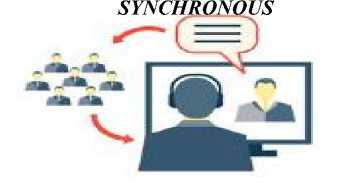
ANEKA

Teachers
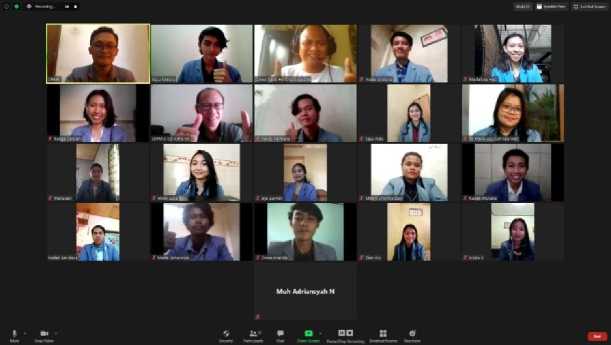
НУЖЬ «■ З?
/J ^з®м Й КД
Conference Video Application
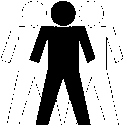
Students
ASYNCHRONOUS

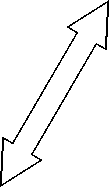
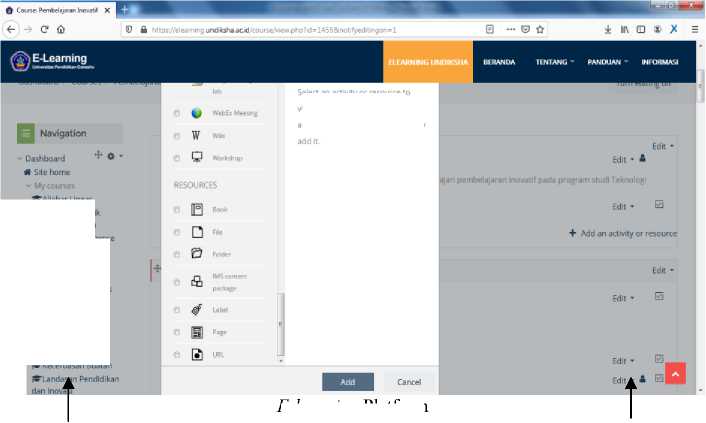
E-learning Platform
ANEKA
ANEKA
select an activity or resource to view its help. Double-click on an activity or resource name to quickly
♦Aljabar Linear
♦Aplikasi Statistik dalam Pendidlkan
♦Artificial Intelligence
♦Assesmen dan Evaluasl Program Pendidlkan
♦ Desain dan Ana lists Algoritma
♦Evaluasl Program Pembelajaran
♦Evaluasl Program Pendidlkan
♦ Kecerdasan Buatan
Fig.1. ANEKA -Based Synchronous and Asynchronous Learning Design
Fig. 1 shows a learning design sketch that combines synchronous and asynchronous learning strategies with inserting ANEKA concepts to obtain quality learning outcomes in terms of students’ positive attitudes and student cognitive abilities. Based on Figure 1, teachers and students are the main actors in the learning process. Teachers and students can use video conferencing applications (for example: Zoom , Meet Google , Webex , and others) to carry out synchronous learning. Besides, teachers can carry out asynchronous learning to train students’ independence in learning through e-learning facilities [28]. Asynchronous learning allows teachers to upload learning material in a variety of file formats (for example: .pdf files, videos, zips , and other files stored in directories) through the storage facilities provided in e-learning . The uploaded files can be downloaded and studied by students whenever and wherever they are.
The ANEKA concept is inserted into synchronous learning to find out the positive attitude of students in following the process of face-to-face learning directly with the teacher through a video conference application. The ANEKA concept is inserted into asynchronous learning to find out the level of student independence in learning making it easier for teachers to know students who have high cognitive abilities.
-
C. Results in the Develop Stage
-
1) Expert’s Evaluation
At this stage was obtained the expert’s evaluation results towards the ANEKA -based Synchronous and Asynchronous learning design sketch. The evaluation results can be seen in Table 1.
Table 1. The Expert’s Evaluation Results towards ANEKA -based Synchronous and Asynchronous Learning Design
|
No |
Respondents |
Items- |
∑ |
Effectiveness Percentage (%) |
|||||||||
|
1 |
2 |
3 |
4 |
5 |
6 |
7 |
8 |
9 |
10 |
||||
|
1 |
Expert-1 |
5 |
4 |
5 |
4 |
4 |
5 |
5 |
5 |
4 |
5 |
46 |
92.00 |
|
2 |
Expert-2 |
4 |
4 |
4 |
4 |
5 |
5 |
5 |
4 |
5 |
4 |
44 |
88.00 |
|
3 |
Expert-3 |
4 |
4 |
4 |
5 |
4 |
4 |
5 |
4 |
5 |
4 |
43 |
86.00 |
|
4 |
Expert-4 |
5 |
5 |
5 |
4 |
5 |
4 |
4 |
4 |
4 |
5 |
45 |
90.00 |
|
Average |
89.00 |
||||||||||||
Table 1 showed the four experts were involved in evaluating the ANEKA -based Synchronous and Asynchronous learning design sketch. There were ten items of instruments used as tools for evaluating the design effectiveness. The intended instrument items included: item-1 about the availability of a video conference application for conducting synchronous learning; item-2 about the availability of an e-learning platform for conducting asynchronous learning; item-3 about the readiness of the ANEKA concept to be inserted into synchronous learning; item-4 about the readiness of the ANEKA concept to be inserted into asynchronous learning; item-5 about the ability of teachers and students to use video conference application; item-6 about the ability of teachers and students to use the e-learning platform; item-7 about the reliability of the video conference application in facilitating synchronous learning; item-8 about the reliability of the e-learning platform in facilitating asynchronous learning; item-9 about the completeness of the material content provided in the e-learning platform; and item-10 about data security in the e-learning platform.
-
2) Design Revision
Based on the results were shown in Table 1, it appears that the average of effectiveness percentage was 89.00%. This means in general ANEKA -based Synchronous and Asynchronous learning design had been included in the very high category when viewed from the categorization of the effectiveness percentage results. Therefore, it was no need to revise again.
-
D. Results in the Disseminate Stage
-
5. Conclusions
When viewed from the results at the Develop stage, generally, ANEKA -based synchronous and asynchronous learning design sketch had ready to be used and disseminated. The distribution of the learning design sketch was done by sending a softcopy of the design sketch to all the heads of IT Vocational Schools in North of Bali so that later the heads were able to instruct the teachers in the schools to implement the ANEKA -based synchronous and asynchronous learning during social distancing .
Based on the learning objectives that had been set previously at the Define stage, the role of ANEKA concepts seems clear. The implementation of synchronous learning by inserting ANEKA concepts was able to show the quality of learning even though the learning process was carried out from each student’s home. This was because there were aspects of ANEKA that was able to be used as a measurement tool to monitor the quality of learning to stay awake. ANEKA aspects that were used as a measurement of monitoring the quality of learning, included: responsibility, clarity of targets, consistency, work ethic, obeying instructions, high integrity, effectiveness, efficiency, innovation, quality-oriented, disciplined, brave, and hard work.
The aspects of ANEKA that can be used as a measurement of monitoring students’ cognitive abilities in terms of student absenteeism and independence to learn through asynchronous learning, included: honest, transparent, confident, careful, independent, and fair. The aspects of ANEKA that can be used as a measurement tool for monitoring students’ positive attitudes in synchronous and asynchronous learning processes, included: participatory, neutral, prioritizing the public interest, tolerant, mutual-cooperation, caring, simple, deliberation of consensus, family, wise, not greedy, giving help, respect, polite, and obey the laws and regulations.
Generally, the results of this research have been able to show the effectiveness level of the synchronous and asynchronous learning design. In principle, this research results are similar to Dada, Alkali, and Oyewola’s research [15] that also showed the research results about the effectiveness of synchronous and asynchronous learning. The results of this research can be the answer to the obstacles found in several studies were conducted by Shahabadi & Uplane in 2015 [12]; Perven in 2016 [13]; Arasaratnam-Smith & Northcote in 2017 [14]; Dada et al . in 2019 [15]; and Cacheiro-Gonzalez et al . in 2019 [16] with inserting ANEKA aspects into synchronous and asynchronous learning strategies, so that positive attitudes and cognitive abilities of students can be measured. Aspects of ANEKA principally source from the internalization of attitudes values based on local wisdom. In general, synchronous and asynchronous learning processes that are inserted aspects of local wisdom can realize an increase in students’ positive attitudes. This was confirmed by the results of the research of Sofyan et al . in 2019 [29] which showed the internalization of aspects of local wisdom into e-modules (where e-modules are one of the teaching materials in asynchronous learning) to realize increased positive attitudes and student enthusiasm for learning. The positive attitude of students in synchronous and asynchronous learning is very important to know to demonstrate the success of the learning strategy implementation. This was reinforced from the results of Keskin & Yurdugül’s research in 2019 [30] which showed the importance of student character in influencing the successful implementation of online learning and blended learning.
Limitations in this research were not found yet the most dominant aspects of ANEKA which the cause of an increase in the quality of cognitive abilities and an increase in students’ positive attitudes in synchronous and asynchronous learning.
This research showed the ANEKA -based synchronous and asynchronous learning design had categorized as a very high level of effectiveness. Therefore, the results of this research succeeded in presenting new knowledge in the form of design used as basic guidelines in carrying out the learning process during social distancing to realize increased cognitive abilities and positive character of students. The future work that can be done to solve limitations in this research is to insert the concept of artificial intelligence into the learning design so that later it will be easier to determine the dominant aspects causing an increase of positive character and cognitive ability of students.
Acknowledgment
The author expressed thanks to the Chairman of the Research and Community Service Institute of the Universitas Pendidikan Ganesha , who had provided a chance and funding for this research.
Список литературы ANEKA-based Asynchronous and Synchronous Learning Design and its Evaluation as Efforts for Improving Cognitive Ability and Positive Character of Students
- M.M. Hassan, T. Mirza, and M.W. Hussain, “A Critical Review by Teachers on the Online Teaching-Learning during the COVID-19,” International Journal of Education and Management Engineering (IJEME), Vol. 10, No. 5, pp. 17-27, 2020.
- H.D. Surjono, A. Muhtadi, and D. Wahyuningsih, “The Implementation of Blended Learning in Multimedia Courses for Undergraduate Students in Indonesia,” International Journal of Information and Education Technology, Vol. 7, No. 10, pp. 783-786, 2017.
- R. Hogan, and M. Devi, “A Synchronous Pedagogy to Improve Online Student Success,” International Journal of Online Pedagogy and Course Design, Vol. 9, No. 3, pp. 61-77, 2019.
- M.H. Lin, H.C. Chen, and K.S. Liu, “A Study of the Effects of Digital Learning on Learning Motivation and Learning Outcome,” EURASIA Journal of Mathematics Science and Technology Education, Vol. 13, No. 7, pp. 3553-3564, 2017.
- J. Politis, and D. Politis, “The Relationship Between an Online Synchronous Learning Environment and Knowledge Acquisition Skills and Traits: The Blackboard Collaborate Experience,” The Electronic Journal of E-Learning, Vol. 14, No. 3, pp. 196-222, 2016.
- V. Chauhan, “Synchronous and Asynchronous Learning,” Imperial Journal of Interdisciplinary Research, Vol. 3, No. 2, pp. 1345-1348, 2017.
- G. Northey, T. Bucic, M. Chylinski, and R. Govind, “Increasing Student Engagement Using Asynchronous Learning,” Journal of Marketing Education, Vol. 2015, pp. 1-10, 2015.
- K. Hadullo, R. Oboko, and E. Omwenga, “Factors Affecting Asynchronous-Learning Quality in Developing Countries: A Qualitative Pre-study of JKUAT University,” International Journal of Education and Development using Information and Communication Technology, Vol. 14, No. 1, pp. 152-163, 2018.
- R.P. Gasparič, and M. Pečar, “Analysis of an Asynchronous Online Discussion as a Supportive Model for Peer Collaboration and Reflection in Teacher Education,” Journal of Information Technology Education: Research, Vol. 15, pp. 369-393, 2016.
- H. Al-Samarraie, “A Scoping Review of Video Conferencing Systems in Higher Education: Learning Paradigms, Opportunities, and Challenges,” International Review of Research in Open and Distributed Learning, Vol. 20, No. 3, pp. 121-140, 2019.
- R.D.O.S. Carmo, and A.P. Franco, “From Face-to-Face Teaching to Online Teaching: The Learning of University Teachers in Distance Education,” Educação em Revista, Vol. 35, pp. 1-28, 2019.
- M.M. Shahabadi, and M. Uplane, “Synchronous and Asynchronous E-learning Styles and Academic Performance of E-learners,” Procedia - Social and Behavioral Sciences, Vol. 176, pp. 129-138, 2015.
- A. Perveen, “Synchronous and Asynchronous E-Language Learning: A Case Study of Virtual University of Pakistan,” Open Praxis, Vol. 8, No. 1, pp. 21-39, 2016.
- L.A. Arasaratnam-Smith, and M. Northcote, “Community in Online Higher Education: Challenges and Opportunities,” The Electronic Journal of E-learning, Vol. 15, No. 2, pp. 188-198, 2017.
- E.G. Dada, A.H. Alkali, and D.O. Oyewola, “An Investigation into the Effectiveness of Asynchronous and Synchronous E-learning Mode on Students’ Academic Performance in National Open University (NOUN), Maiduguri Centre,” International Journal of Modern Education and Computer Science (IJMECS), Vol. 11, No. 5, pp. 54-64, 2019.
- M.L. Cacheiro-Gonzalez, A. Medina-Rivilla, M.C. Dominguez-Garrido, and M. Medina-Dominguez, “The Learning Platform in Distance Higher Education: Student’s Perceptions,” Turkish Online Journal of Distance Education-TOJDE, Vol. 20, No. 1, pp. 71-95, 2019.
- B.A. Hibra, L. Hakim, and T. Sudarwanto, “Development of Vlog Learning Media (Video Tutorial) on Student Materials Tax at SMK PGRI 1 Jombang,” International Journal of Educational Research Review, Vol. 4, No. 3, pp. 435-438, 2019.
- D.L. Wardani, I.N.S. Degeng, and A. Cholid, “Developing Interactive Multimedia Model 4D for Teaching Natural Science Subject,” International Journal of Education and Research, Vol. 7, No. 1, pp. 63-72, 2019.
- G.A.D. Sugiharni, “The Development of Interactive Instructional Media Oriented to Creative Problem Solving Model on Function Graphic Subject,” Journal of Educational Research and Evaluation, Vol. 2, No. 4, pp. 183-189, 2018.
- S.A. Sari, and Y.S. Rezeki, “The Development of An Ingenious Circuit based on Chemo-Edutainment Learning,” International Journal of Educational Research Review, Vol. 4, No. 1, pp. 15-25, 2019.
- Sutirna, “Subject Teachers’ Perceptions of Academic Mentoring and Counseling Services,” COUNS-EDU: The International Journal of Counseling and Education, Vol. 4, No. 4, pp.129-133, 2019.
- I. Dalimoenthe, E. Clara, Y. Akmal, A.T. Alkhudri, B.P. Andhyni, and I.D. Sarwestri, “Psycho-Social Education (PSE) Model: Conceptualisation and Implementation of Empowerment Models for Families Evicted From Cities,” International Journal of Innovation, Creativity and Change, Vol. 13, No.1, pp. 1052-1072, 2020.
- M.R.R. Razak, M. Dahong, J. Ahmad, H. Dema, and A. Mustanir, “The Effect of Siri’s Marriage on Government Administration,” International Journal of Sciences: Basic and Applied Research (IJSBAR), Vol. 42, No. 3, pp.171-184, 2018.
- S. Nawawi, Nizkon, and A.T. Azhari, “Analysis of the Level of Critical Thinking Skills of Students in Biological Materials at Muhammadiyah High School in Palembang City,” Universal Journal of Educational Research, Vol. 8, No.3D, pp. 47-53, 2020.
- Y. Maryansyah, “An Analysis on Readability of English Reading Texts for Grade IX Students at MTSN 2 Kota Bengkulu,” Premise Journal, Vol. 5, No. 1, pp. 69-88, 2016.
- H. Febriansyah, and D.M.A. Ramdlany, “The Future of Government Model After Mentality and Bureaucracy Reform in Indonesia,” The Social Sciences, Vol. 11, No. 7, pp. 1297-1304, 2016.
- D.G.H. Divayana, I.G. Sudirtha, and I.K. Gading, “Application Design of Countenance Evaluation based on Tri Hita Karana-ANEKA for Evaluating the Students’ Computer Capability and Students’ Character,” Cogent Psychology, Vol. 7, pp.1-18, 2020.
- B. Rawat, and S.K. Dwivedi, “An Architecture for Recommendation of Coursesin E-learning System,” International Journal of Information Technology and Computer Science (IJITCS), Vol. 9, No. 4, pp. 39-47, 2017.
- H. Sofyan, E. Anggereini, and J. Saadiah, “Development of E-Modules Based on Local Wisdom in Central Learning Model at Kindergartens in Jambi City,” European Journal of Educational Research, Vol. 8, No. 4, pp. 1137 -1143, 2019.
- S. Keskin, and H. Yurdugül, “Factors Affecting Students’ Preferences for Online and Blended learning: Motivational vs Cognitive,” European Journal of Open, Distance and e-Learning, Vol. 22, No. 2, pp. 72-86, 2019.

